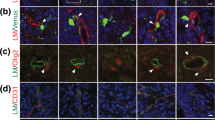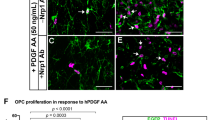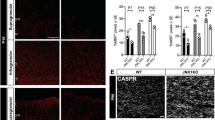Abstract
Depending on the stage of development, a growth factor can mediate cell proliferation, survival or differentiation. The interaction of cell-surface integrins with extracellular matrix ligands can regulate growth factor responses and thus may influence the effect mediated by the growth factor. Here we show, by using mice lacking the α6 integrin receptor for laminins, that myelin-forming oligodendrocytes activate an integrin-regulated switch in survival signalling when they contact axonal laminins. This switch alters survival signalling mediated by neuregulin from dependence on the phosphatidylinositol-3-OH kinase (PI(3)K) pathway to dependence on the mitogen-activated kinase pathway. The consequent enhanced survival provides a mechanism for target-dependent selection during development of the central nervous system. This integrin-regulated switch reverses the capacity of neuregulin to inhibit the differentiation of precursors, thereby explaining how neuregulin subsequently promotes differentiation and survival in myelinating oligodendrocytes. Our results provide a general mechanism by which growth factors can exert apparently contradictory effects at different stages of development in individual cell lineages.
This is a preview of subscription content, access via your institution
Access options
Subscribe to this journal
Receive 12 print issues and online access
$209.00 per year
only $17.42 per issue
Buy this article
- Purchase on Springer Link
- Instant access to full article PDF
Prices may be subject to local taxes which are calculated during checkout








Similar content being viewed by others
References
Barres, B. A. & Raff, M. C. Control of oligodendrocyte number in the developing rat optic nerve. Neuron 12, 935–942 (1994).
Barres, B. A. & Raff, M. C. Axonal control of oligodendrocyte development. J. Cell Biol. 147, 1123–1128 (1999).
Buonanno, A. & Fischbach, G. D. Neuregulin and ErbB receptor signaling pathways in the nervous system. Curr. Opin. Neurobiol. 11, 287–296 (2001).
Barres, B. A. et al. Cell death and control of cell survival in the oligodendrocyte lineage. Cell 70, 31–46 (1992).
Noble, M., Murray, K., Stroobant, P., Waterfield, M. D. & Riddle, P. Platelet-derived growth factor promotes division and motility and inhibits premature differentiation of the oligodendrocyte/type-2 astrocyte progenitor cell. Nature 333, 560–562 (1988).
Canoll, P. D. et al. GGF/neuregulin is a neuronal signal that promotes the proliferation and survival and inhibits the differentiation of oligodendrocyte progenitors. Neuron 17, 229–243 (1996).
Canoll, P. D., Kraemer, R., Teng, K. K., Marchionni, M. A. & Salzer, J. L. GGF/neuregulin induces a phenotypic reversion of oligodendrocytes. Mol. Cell. Neurosci. 13, 79–94 (1999).
Calaora, V. et al. Neuregulin signaling regulates neural precursor growth and the generation of oligodendrocytes in vitro. J. Neurosci. 21, 4740–4751 (2001).
Ebner, S., Dunbar, M. & McKinnon, R. D. Distinct roles for PI3K in proliferation and survival of oligodendrocyte progenitor cells. J. Neurosci. Res. 62, 336–345 (2000).
Calver, A. R. et al. Oligodendrocyte population dynamics and the role of PDGF in vivo. Neuron 20, 869–882 (1998).
Flores, A. I. et al. Akt-mediated survival of oligodendrocytes induced by neuregulins. J. Neurosci. 20, 7622–7630 (2000).
Fernandez, P. A. et al. Evidence that axon-derived neuregulin promotes oligodendrocyte survival in the developing rat optic nerve. Neuron 28, 81–90 (2000).
Giancotti, F. G. & Ruoslahti, E. Integrin signaling. Science 285, 1028–1032 (1999).
Milner, R. & ffrench-Constant, C. A developmental analysis of oligodendroglial integrins in primary cells: changes in αv-associated β subunits during differentiation. Development 120, 3497–3506 (1994).
Milner, R. et al. Expression of αvβ3 and αvβ8 integrins during oligodendrocyte precursor differentiation in the presence and absence of axons. Glia 21, 350–360 (1997).
Blaschuk, K. L., Frost, E. E. & ffrench-Constant, C. The regulation of proliferation and differentiation in oligodendrocyte progenitor cells by αV integrins. Development 127, 1961–1969 (2000).
Milner, R., Edwards, G., Streuli, C. & ffrench-Constant, C. A role in migration for the αvβ1 integrin expressed on oligodendrocyte precursors. J. Neurosci. 16, 7240–7252 (1996).
Frost, E. E., Buttery, P. C., Milner, R. & ffrench-Constant, C. Integrins mediate a neuronal survival signal for oligodendrocytes. Curr. Biol. 9, 1251–1254 (1999).
Morissette, N. & Carbonetto, S. Laminin α2 chain (M chain) is found within the pathway of avian and murine retinal projections. J. Neurosci. 15, 8067–8082 (1995).
Tian, M. et al. Laminin-α2 chain-like antigens in CNS dendritic spines. Brain Res. 764, 28–38 (1997).
Powell, S. K., Williams, C. C., Nomizu, M., Yamada, Y. & Kleinman, H. K. Laminin-like proteins are differentially regulated during cerebellar development and stimulate granule cell neurite outgrowth in vitro. J. Neurosci. Res. 54, 233–247 (1998).
McGowan, K. A. & Marinkovich, M. P. Laminins and human disease. Microsc. Res. Tech. 51, 262–279 (2000).
Georges-Labouesse, E. et al. Absence of integrin α6 leads to epidermolysis bullosa and neonatal death in mice. Nature Genet. 13, 370–373 (1996).
Reynolds, B. A. & Weiss, S. Generation of neurons and astrocytes from isolated cells of the adult mammalian central nervous system. Science 255, 1707–1710 (1992).
Vartanian, T., Goodearl, A., Viehover, A. & Fischbach, G. Axonal neuregulin signals cells of the oligodendrocyte lineage through activation of HER4 and Schwann cells through HER2 and HER3. J. Cell Biol. 137, 211–220 (1997).
Osterhout, D. J., Wolven, A., Wolf, R. M., Resh, M. D. & Chao, M. V. Morphological differentiation of oligodendrocytes requires activation of Fyn tyrosine kinase. J. Cell Biol. 145, 1209–1218 (1999).
Kramer, E. M., Klein, C., Koch, T., Boytinck, M. & Trotter, J. Compartmentation of Fyn kinase with glycosylphosphatidylinositol-anchored molecules in oligodendrocytes facilitates kinase activation during myelination. J. Biol. Chem. 274, 29042–29049 (1999).
Sperber, B. R. et al. A unique role for Fyn in CNS myelination. J. Neurosci. 21, 2039–2047 (2001).
Shimamura, A., Ballif, B. A., Richards, S. A. & Blenis, J. Rsk1 mediates a MEK–MAP kinase cell survival signal. Curr. Biol. 10, 127–135 (2000).
Park, S. K., Miller, R., Krane, I. & Vartanian, T. The erbB2 gene is required for the development of terminally differentiated spinal cord oligodendrocytes. J. Cell Biol. 154, 1245–1258 (2001).
Georges-Labouesse, E., Mark, M., Messaddeq, N. & Gansmuller, A. Essential role of α6 integrins in cortical and retinal lamination. Curr. Biol. 8, 983–986 (1998).
Lallier, T. E., Whittaker, C. A. & DeSimone, D. W. Integrin α6 expression is required for early nervous system development in Xenopus laevis. Development 122, 2539–2554 (1996).
Zhang, Z. & Galileo, D. S. Retroviral transfer of antisense integrin α6 or α8 sequences results in laminar redistribution or clonal cell death in developing brain. J. Neurosci. 18, 6928–6938 (1998).
Burne, J. F., Staple, J. K. & Raff, M. C. Glial cells are increased proportionally in transgenic optic nerves with increased numbers of axons. J. Neurosci. 16, 2064–2073 (1996).
David, S., Miller, R. H., Patel, R. & Raff, M. C. Effects of neonatal transection on glial cell development in the rat optic nerve: evidence that the oligodendrocyte-type 2 astrocyte cell lineage depends on axons for its survival. J. Neurocytol. 13, 961–974 (1984).
Pinkas-Kramarski, R. et al. Brain neurons and glial cells express Neu differentiation factor/heregulin: a survival factor for astrocytes. Proc. Natl Acad. Sci. USA 91, 9387–9391 (1994).
Corley, S. M., Ladiwala, U., Besson, A. & Yong, V. W. Astrocytes attenuate oligodendrocyte death in vitro through an α6 integrin–laminin-dependent mechanism. Glia 36, 281–294 (2001).
Meyer, D. & Birchmeier, C. Multiple essential functions of neuregulin in development. Nature 378, 386–390 (1995).
Frisch, S. M. & Screaton, R. A. Anoikis mechanisms. Curr. Opin. Cell Biol. 13, 555–562 (2001).
Osterhout, D. J., Marin-Husstege, M., Abano, P. & Casaccia-Bonnefil, P. Molecular mechanisms of enhanced susceptibility to apoptosis in differentiating oligodendrocytes. J. Neurosci. Res. 69, 24–29 (2002).
Baron, W., Metz, B., Bansal, R., Hoekstra, D. & de Vries, H. PDGF and FGF-2 signaling in oligodendrocyte progenitor cells: regulation of proliferation and differentiation by multiple intracellular signaling pathways. Mol. Cell. Neurosci. 15, 314–329 (2000).
Stariha, R. L. et al. Role of extracellular signal-regulated protein kinases 1 and 2 in oligodendroglial process extension. J. Neurochem. 68, 945–953 (1997).
Richardson, W. D., Pringle, N., Mosley, M. J., Westermark, B. & Dubois-Dalcq, M. A role for platelet-derived growth factor in normal gliogenesis in the central nervous system. Cell 53, 309–319 (1988).
Vemuri, G. S. & McMorris, F. A. Oligodendrocytes and their precursors require phosphatidylinositol 3-kinase signaling for survival. Development 122, 2529–2537 (1996).
Almeida, E. A. et al. Mouse egg integrin α6β1 functions as a sperm receptor. Cell 81, 1095–1104 (1995).
Vitry, S., Avellana-Adalid, V., Hardy, R., Lachapelle, F. & Baron-Van Evercooren, A. Mouse oligospheres: from pre-progenitors to functional oligodendrocytes. J. Neurosci. Res. 58, 735–751 (1999).
Ranscht, B., Clapshaw, P. A., Price, J., Noble, M. & Seifert, W. Development of oligodendrocytes and Schwann cells studied with a monoclonal antibody against galactocerebroside. Proc. Natl Acad. Sci. USA 79, 2709–2713 (1982).
Relvas, J. B. et al. Expression of dominant-negative and chimeric subunits reveals an essential role for β1 integrin during myelination. Curr. Biol. 11, 1039–1043 (2001).
Acknowledgements
We thank members of the ffrench-Constant laboratory for discussions, and L. Decker for advice on neurosphere cultures. This work was supported by the Wellcome Trust and the Multiple Sclerosis Society of Great Britain and Northern Ireland, and by a fellowship from the NIH (to H.C.), a Wellcome Trust research leave fellowship (to C.f.-C.) and a Dutch Multiple Sclerosis Foundation fellowship (to W.B.).
Author information
Authors and Affiliations
Corresponding author
Ethics declarations
Competing interests
The authors declare no competing financial interests.
Rights and permissions
About this article
Cite this article
Colognato, H., Baron, W., Avellana-Adalid, V. et al. CNS integrins switch growth factor signalling to promote target-dependent survival. Nat Cell Biol 4, 833–841 (2002). https://doi.org/10.1038/ncb865
Received:
Revised:
Accepted:
Published:
Issue Date:
DOI: https://doi.org/10.1038/ncb865
This article is cited by
-
Chronic oligodendrocyte injury in central nervous system pathologies
Communications Biology (2022)
-
Laminin α2, α4, and α5 Chains Positively Regulate Migration and Survival of Oligodendrocyte Precursor Cells
Scientific Reports (2019)
-
Engineered 3D-printed artificial axons
Scientific Reports (2018)
-
Myelination is delayed during postnatal brain development in the mdx mouse model of Duchenne muscular dystrophy
BMC Neuroscience (2017)
-
Differential Regulation of MeCP2 Phosphorylation by Laminin in Oligodendrocytes
Journal of Molecular Neuroscience (2017)



